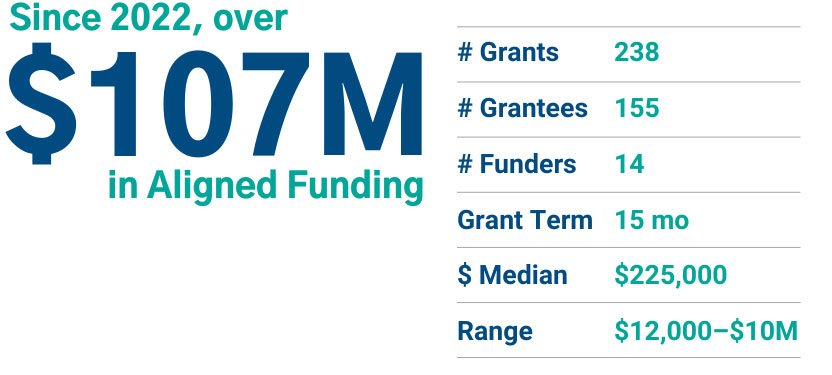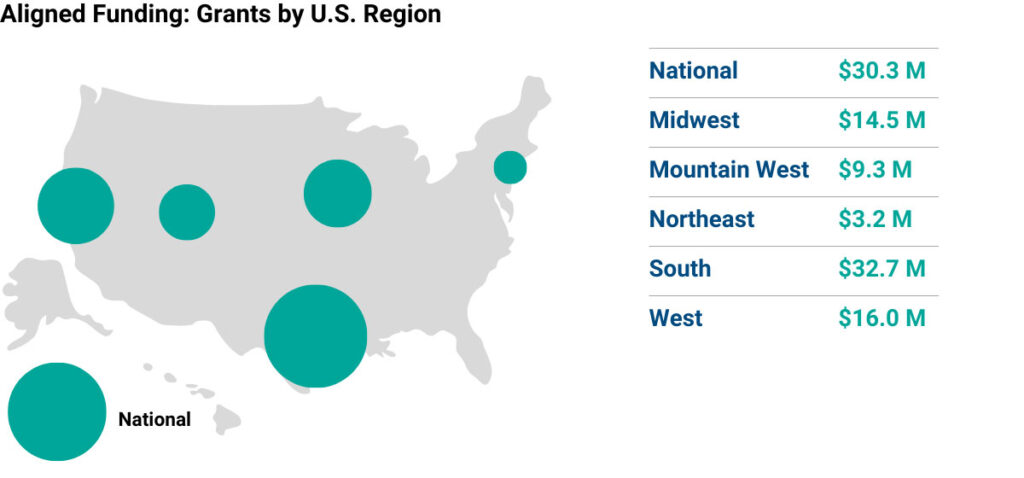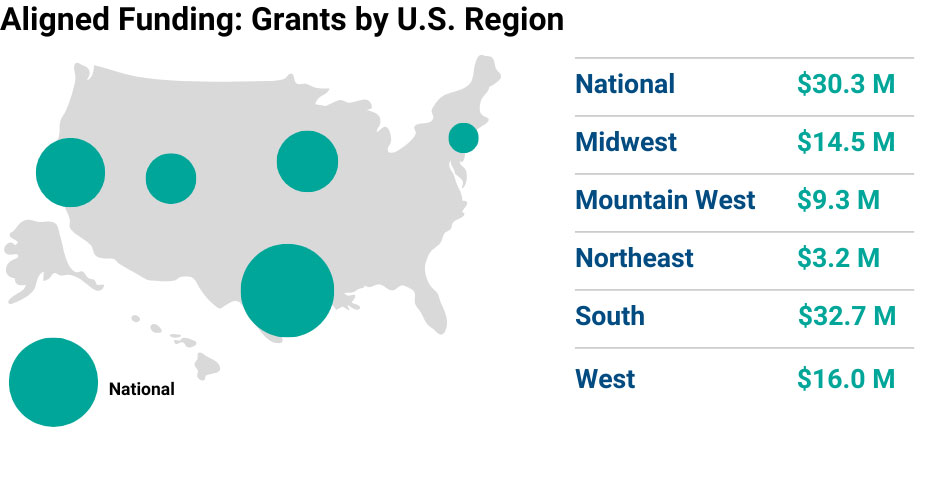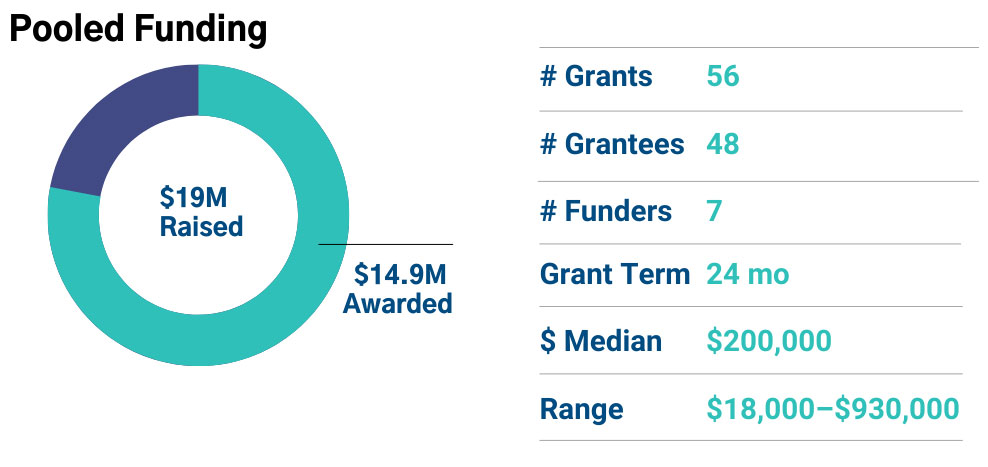About the Work
Clean, reliable water lets communities prosper and ecosystems thrive. Unfortunately, millions of people lack access to safe drinking water, many of our rivers, lakes and wetlands are in peril, and water’s benefits are unevenly shared. Funding policy and programs have not been keeping up with the pace and scale of these challenges.
The ongoing implementation of the 2021 Bipartisan Infrastructure Law (BIL) and the 2022 Inflation Reduction Act (IRA) offers a once-in-a-generation opportunity to transform how our nation’s water resources and systems are managed, and who they serve—in ways that advance environmental, health, justice, and climate goals.
For philanthropy, this public funding represents a call to action: support a growing national movement to ensure water meets the needs of people and nature in the face of climate change.
The Water Solutions Fund responds to this call by pooling and aligning philanthropic resources and working with the field to ensure BIL and IRA implementation realize their full promise by focusing on policy, power, and projects. The Water Solutions Fund provides organizations with holistic support to respond to urgent needs and build for long-term impact. Funders contribute resources to the Water Solutions Fund in two ways:
- Pooled Funding
Directing funding through the Water Foundation in order to take advantage of its staff, political experience, and advocacy capacity - Aligned Funding
Making grants directly, while learning and coordinating alongside other funders.
The Water Solutions Fund is made possible by the Water Table, a philanthropic collaborative that delivers coordinated resources for a sustainable and equitable water future in the US.

Since 2022, pooled and aligned funding total more than $122 M supporting 182 organizations to ensure water infrastructure funding meets the needs of people and nature.
Aligned Funding Snapshot
In early 2024, we surveyed funders to assess broad investment trends, focusing on how much money has been granted to support the field with implementation of BIL and IRA, how many organizations are receiving support, and where that support touches ground.




Pooled Funding Snapshot
To inform pooled fund grants, the Water Foundation: meets with leaders working across the country to implement BIL and IRA to learn about what is working and where there are challenges; conducts focused interviews with grantees to understand how philanthropy can best support movement leaders; and surveys aligned funders to understand where philanthropic resources are being targeted and where there might be gaps. Appendix A includes a list of pooled fund grant awards.


Spotlight on Projects
Through pooled and aligned funding, the Water Solutions Fund has directed funding to help ensure infrastructure projects lead to better outcomes for communities. Individually, these projects are improving access to drinking water and wastewater services; building community, forest, floodplain, and coastal resilience; and advancing nature-based water infrastructure. Collectively, the projects represent what we can achieve together when we join across political divides to prioritize investment in water. Here is a short overview of some of the projects that have made a big impact, thanks to our partners and grantees.
These are just some of the projects the Water Solutions Fund supports. To learn more about any of these projects, or for more information about the 35+ projects that the Water Solutions Fund is monitoring, please contact anajera@waterfdn.org or jsokolove@waterfdn.org.
Hopi and Kearns Canyon, Arizona
In 2016, the Hopi Tribe in Arizona estimated three-quarters of people living on its land were drinking water with unsafe levels of arsenic. Tasteless, odorless, and clear, arsenic-tainted water is hard to detect, but can lead to a range of illnesses including cancer, kidney and heart disease, and diabetes. With $8.7M in BIL funding and support from the Universal Access to Clean Water for Tribal Communities initiative, 2022 brought a new water treatment facility to the Hopi Reservation, providing safe water to more than 1,500 people. In 2023, $6.6M more was made available to bring clean drinking water to Kearns Canyon.
photo: © David Wallace – USA TODAY NETWORK
Port Arthur, Texas
Ninety miles outside of Houston is Port Arthur, Texas—a major port for the oil, gas, and chemical industry that has also seen a significant amount of storm and hurricane damage over the years. Thanks to organizers at Community In-Power and Development Association (CIDA), with help from the Anthropocene Alliance, it is now also home to nearly $1M in federal coastal resilience planning funding. With this investment, preliminary plans have been drawn up for wetland restoration, rainwater harvesting parks, and tree-planting projects in West Port Arthur. Between this and other climate and flood resilience efforts, Port Arthur is on track to restore habitat and water quality in a historically marginalized community.
Charleston, South Carolina
For generations, Black families have made their homes and grown their families in the Rosemont neighborhood. As sea levels rise due to a changing climate and natural protections are removed by new development, ever-present flooding has become a problem. With proposed mitigations not extending far enough to protect the community, the Lowcountry Alliance for Model Communities (LAMC) received a $300,000 planning grant from NOAA’s climate resilience program to find a more comprehensive solution through the Rosemont Resilience Plan.
Alameda County, California
Alameda Creek is the largest local tributary to the San Francisco Bay and has historically produced the largest amount of Chinook salmon, lamprey, and steelhead in the South Bay. After the Alameda County Water District removed barriers and installed fish ladders, these fish populations had access to the upper Alameda Creek watershed for the first time in 50 years. With the Sunol Valley Fish Passage Project, CalTrout continues these remediation efforts with $4M in BIL funding through NOAA, focusing on extending accessibility to more than 20 miles of prime habitat in Alameda Creek.
Milwaukee, Wisconsin
In Wisconsin, much of the drinking water still finds its way to residents through lead service lines. More than 150,000 lead pipes supply communities with water, with Milwaukee residents having the largest number of Wisconsin’s lead service lines. With support from Milwaukee Water Commons, Green Infrastructure Leadership Exchange, WaterNow Alliance, US Water Alliance, and Groundwork USA, Milwaukee is set to receive $30M in BIL investment through the Wisconsin Drinking Water State Revolving Fund to replace these lead service lines.
Communications Campaign: America Wins with Water
While these projects lay the groundwork for substantial gains for people and nature, their early stages and dispersed nature make it difficult to make the case that the nation’s investment in water has been successful, let alone that future investment is needed.

To tell this story and cement the shift in how policymakers and the public think about the ways in which the US invests in water infrastructure, the Water Solutions Fund launched the America Wins with Water communications campaign in August 2024. The campaign amplifies and supports the grounded project and policy work pooled and aligned partners are accomplishing.
Priority states for the America Wins with Water communications campaign include Alaska, Arizona, California, Idaho, Montana, North Carolina, Louisiana, and Washington. Relying on a combination of researched messaging, traditional media outreach, paid advertising, and digital and social media, the campaign seeks to communicate directly with key decision makers, like elected officials, as well as the general public, about the national treasure and unique unifier that is America’s water.
The activities of the national communications firm will complement the existing work of partners such as:
- The Water Hub, which has launched a website and associated resources focused on the theme of Just Infrastructure, highlighting “water investments at work” across drought resilience, flood justice, urban greening, and access to drinking water and sanitation services.
- The Water Program Portal and its opportunities dashboard and comprehensive BIL and IRA outcomes analyses.
- The Value of Water campaign coordinated by the US Water Alliance.
- Government agencies collecting their own project stories, like the EPA, which recently launched a website dedicated to sharing the stories of State Revolving Fund projects, and NOAA Fisheries, which is collecting stories of its work moving BIL and IRA resources.
Beyond this, the Water Solutions Fund is committed to sharing authentic, actionable stories. Community leaders—including environmental and community-based organizations—are critical to highlighting the unique and nuanced reasons these projects are integral to their communities and families.
